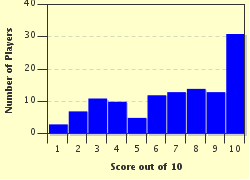Quiz Answer Key and Fun Facts
1. We start with 'Digitalis purpurea', a flowering plant found not only in England but throughout the temperate regions of Europe. Known as the original source of the heart medicine digoxin, this is the floral emblem of the City of Birmingham. Which flower is this?
2. 'Pulsatilla vulgaris' is a species of flowering plant in the buttercup family that is widely found throughout Europe on terrain such as chalk and limestone downs. In England, it is particularly prevalent in the Cotswolds. The county flower of Cambridgeshire, what is this plant?
3. 'Cardamine pratensis' is a flowering plant in the cabbage family. Common throughout Britain, it can also be found growing wild in Europe and much of western Asia. Found in either pink or white, which plant is the floral emblem of Cheshire?
4. 'Polemonium caeruleum' is a hardy, perennial, flowering plant in the phlox family. Found growing wild throughout the temperate regions of Europe, its flowers come in both lavender and white. The country floral emblem of Derbyshire, which flower is this?
5. A perennial, flowering plant, 'Primula vulgaris' is native to southern and western Europe and is one of the most common sights in the fields, open woods and shaded hedgerows of Britain. The floral emblem of Devon, which plant is this?
6. The distinctive pale yellow flowers with darker central trumps of the splendidly named 'Narcissus pseudonarcissus' are a common spring-time sight throughout England and much of western Europe. The official floral emblem of Gloucestershire, which plant is this?
7. A flowering plant in the lily family, 'Fritillaria meleagris' has a distinctive chequered pattern on flowers ranging from purple to white. Native to Europe and western Asia, this is an endangered plant that is now rarely found growing wild. The floral emblem of Oxfordshire, what is this plant?
8. 'Primula elatior' is a herbaceous, flowering plant that in the U.K. is now rarely seen outside East Anglia, although it is still found in damp woods and meadows throughout northern Europe. The floral emblem of Suffolk, which flower is this?
9. A vigorous, evergreen climber, 'Lonicera periclymenum' is a flowering plant native to the UK and much of Europe. Often seen in woodland, hedgerows or scrubland surrounded by bright red berries, this is the floral emblem of Warwickshire. Which plant is this?
10. A herbaceous perennial flowering plant, 'Campanula rotundifolia' is a member of the bellflower family. It is most often found on Britain's grasslands and heaths, where the soil is lacking nutrients. The official floral emblem of Yorkshire, what is this plant?
Source: Author
EnglishJedi
This quiz was reviewed by FunTrivia editor
WesleyCrusher before going online.
Any errors found in FunTrivia content are routinely corrected through our feedback system.

